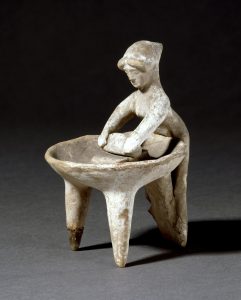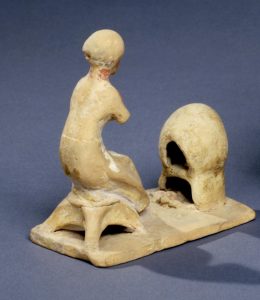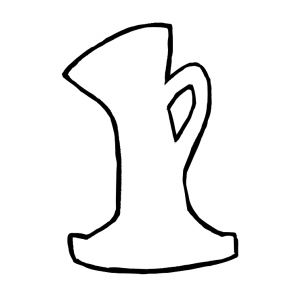Diet and Food Production
Kaylee Janzen
The ancient Greek diet included many different foods. They ate vegetables such as beans, garlic, lentils, and radishes. Fish like herring and anchovies were eaten both pickled and fresh. However, meat such as beef, lamb, pork and goat were eaten much less often and were often involved in ritual feasting (e.g. Ath. 1.15). They also had cheese, olives, eggs, honey, apples, figs and dates. But most importantly, bread. Bread was a staple food in the Greek household. In fact, it was used as a utensil and a napkin as well as a food. When eating something that today we might eat with a spoon, like a soup or stew, the ancient Greeks would instead use bread. And in place of napkins they would sometimes have small pieces of bread on which they could wipe their fingers. At the end of the meal it was common to throw these pieces of bread to their dogs.
The first step of making bread is grinding the grain. The most common grain used was barley. This bread was called maza and was simply ground barley mixed with water, then cooked over a fire. There are some mentions of leavened bread by ancient Greek authors but this was a rarity. To grind the grain the ancient Greeks used querns. A quern consists of two stones that the grain is placed in between. The upper stone was tapered at the end to make it easier to grip while the lower stone was often slanted so that the grain would slide down. There was also often a herringbone pattern on the stones to guide the ground grain down the sloped stone. Originally it was thought that mortar and pestles were used as well but now it is more often thought that they were used for grinding things other than grain.

If they were used in the bread making process it was for removing the husks, not grinding the grain. Because of the method of grinding grain, it can sometimes be difficult to tell whether a figure is depicted grinding grain or rolling dough as the two actions can appear quite similar.
For example, this figurine depicts a woman either grinding grain or rolling dough on a table. Both actions depict her making bread, a task commonly represented with such figures. Since the bread making figures depict women doing these actions, we can learn that bread-making was a task for women in the ancient household.
Once the grain was ground up and the dough was rolled, it was time to bake the bread. There were multiple different methods of baking the bread. One of the more common methods was the usage of a dome shaped cover. These covers may or may not have a base for the food. If it was just the cover one would clear a space on the ground, light some coals and cover them with this lid. Once the inside was warmed the coals would be moved to the side and the dough placed inside. The dough could be placed directly on the ground or on a layer of leaves. Then the dome would be closed again and other coals would be heaped up over the cover and the bread was left to bake.

There were other kinds of ovens as well, like this one depicted in this figurine. A fire would simply be lit beneath the oven, but it required someone to keep the fire stoked to maintain a consistent temperature and to turn the contents of the oven and make sure the item cooked evenly. Unlike the bread-making figurines, there are some figures of uncertain gender depicted with ovens. This could indicate that perhaps male members of the household might work around the fire as well.
Some ovens could have the tops removed to become braziers as well. Some braziers had grooves at the side where spits could be placed to roast items. Circular braziers could have bowls placed over them to heat the content in the bowls. There were also grills which could be placed directly over coals or on braziers, used to grill meats and vegetables.
Mystery Utensils
Not every kitchen utensil is immediately recognizable. For example, archaeologists have discovered an artifact shaped like this at various sites.

There have been multiple interpretations as to what it may have been used for. Some thought it was used in metallurgy and attached to bellows, others suggested it carried torches, or maybe it was used as an upside down rhyton (a conical container for liquids) in some sort of ritual. In the end, scholars used a combination of primary literary sources and images on vessels to deduce what this item would have once been used for. A joke found in Aristophanes’ Peace (lines 893-894) about a character’s legs being shaped like this tool provides the item with its name, a lasana (λάσανα) and its use was discovered depicted on a vessel. These items were used to support cooking vessels over a fire and were very useful since they could make any vessel into a cauldron. One could even adjust for the size of the vessel by moving the pieces closer together or further apart.
Of course, there were other utensils used in food production as well. Most of these tools were made of terracotta but there are a few which were bronze. For example, they had bronze cheese graters, which look very similar to the cheese graters we still use in North America today. The ancient Greeks did not use knives at meals but they did have iron cleavers for cutting meat. Archaeologists have even discovered a saucer inscribed with different kitchen utensils. The list includes dishes, platters, little dishes, cups, oil-flasks, half-chous (a little jug), and bowls.
Bibliography and Further Reading
- Jasny, N. 1950. “The Daily Bread of the Ancient Greeks and Romans.” Osiris 9: 227–53.
- Shear, T. L. 1975, “The Athenian Agora: Excavations of 1973-1974.” Hesperia 44: 331-374.
- Sparkes, B. A. 1962. “The Greek Kitchen.” Journal of Hellenic Studies 82: 121–37.
- Morris, S.P. 1985. “Λ AΣ ANA: A Contribution to the Ancient Greek Kitchen.” Hesperia 54.4: 393–409.
- West, W.C. 2011. “A Note on Greek Kitchenware for Eating Gruel.” Zeitschrift für Papyrologie und Epigraphik 179: 126–28.

